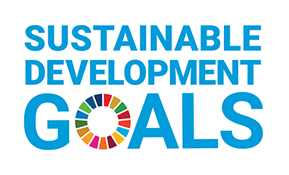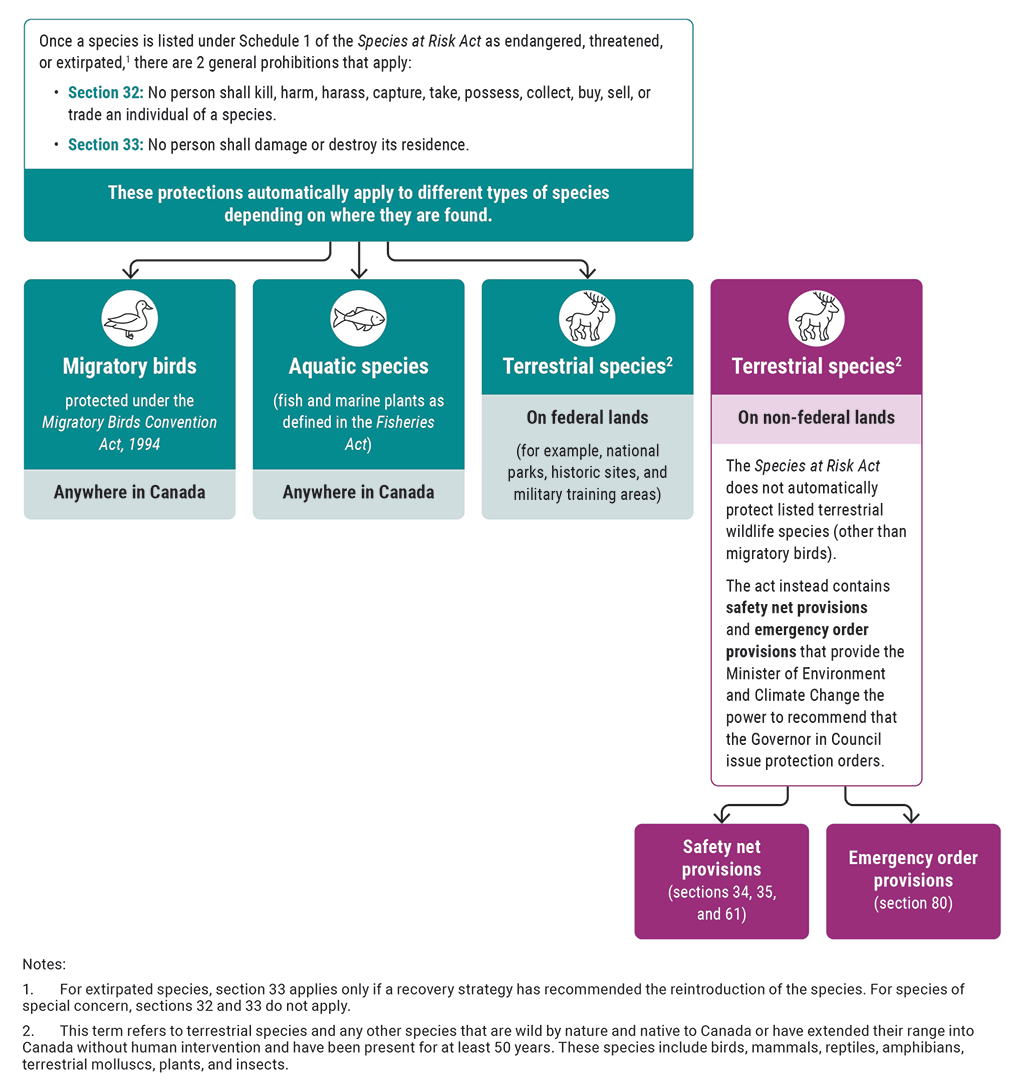2023 Reports 1 to 5 of the Commissioner of the Environment and Sustainable Development to the Parliament of Canada
Report 3—Discretionary Powers to Protect Species at Risk
At a Glance
Overall, Environment and Climate Change Canada did not have a timely and evidence-based approach to informing the use of safety net and emergency order provisions to protect terrestrial wildlife species on non-federal lands.
Environment and Climate Change Canada did not proactively use readily available information about threats to wildlife species and their habitats, declining species population trends, and the lack of protection of critical habitat on non-federal lands to inform decisions on whether to advise the Minister of Environment and Climate Change on the use of the safety net and emergency order provisions. Since the Species at Risk Act came fully into force almost 20 years ago, a total of 3 emergency orders and no safety net orders have been issued to address imminent threats to species on non-federal lands. These instances were triggered by pressure from sources external to the federal government. Providing timely and evidence-based advice for the use of the safety net and emergency order provisions would help protect threatened species where and when needed, supporting their recovery and aligning with federal commitments to halt and reverse nature loss by 2030 in Canada.
The Species at Risk Act provides the federal government with powers to protect wildlife species and their habitats on non-federal lands. This includes taking action in the absence of legislation in the provinces and territories to effectively protect threatened and endangered species and their critical habitat, which federal, provincial, and territorial ministers responsible for wildlife agreed to 27 years ago, under the 1996 national Accord for the Protection of Species at Risk. Environment and Climate Change Canada has taken important first steps by establishing conservation agreements with the provinces, the territories, and Indigenous groups to protect species such as the boreal and southern mountain caribou. The government needs to take stronger actions to protect and recover species and their habitats effectively. This includes completing and approving policies on using the safety net and emergency order provisions that Parliament has established to protect these species, working with partners to strengthen conservation agreements, and collecting and using information on conservation agreements to ensure that they contribute to recovery objectives and support decisions for protecting species and habitats.
Why we did this audit
- For Canada to take action to protect terrestrial species most in need of attention, the government needs policies and systems to facilitate timely and evidence-based advice to the minister on the use of the safety net and emergency order provisions.
- The government can mitigate threats and prevent the further decline of species by establishing these provisions as credible options for when there are imminent threats or when there are no measures that protect the species, the residences of its individuals, or its critical habitat.
- Proactively collecting and assessing available information and data can help ensure that the Minister of Environment and Climate Change receives timely advice on whether a critical habitat or a species on non‑federal lands requires protection.
Key findings
- Environment and Climate Change Canada did not have a proactive approach in support of timely advice on the use of the safety net and emergency order provisions.
- Environment and Climate Change Canada did not have complete policies and guidelines for the safety net and emergency order provisions.
- Environment and Climate Change Canada took important first steps by establishing conservation agreements for boreal and southern mountain caribou.
Key facts and figures
- According to the Committee on the Status of Endangered Wildlife in Canada, an independent panel that advises the federal government, the number of new wildlife species at risk has increased steadily over the past 25 years, by an average of about 4% each year.
- Data on species from December 2022 indicates that 84% of terrestrial species assessed or reassessed as endangered have experienced an overall lack of progress in their recovery.
- Since the Species at Risk Act came fully into force in 2004, the Governor in Council has issued a total of 3 emergency orders and no safety net orders to address imminent threats on non-federal lands.
Highlights of our recommendations
- Environment and Climate Change Canada, in collaboration with the provinces and territories and with input from Fisheries and Oceans Canada and Parks Canada as appropriate, should establish a transparent approach to providing advice on the protection of wildlife species and critical habitat to allow for timely and informed recommendations on the use of safety net and emergency order provisions.
- Environment and Climate Change Canada should work with its partners to strengthen conservation agreements to include milestones, measurable targets, clear accountability measures, and sufficient information to track and assess meaningful progress and results to generate conservation agreements that can be used as mechanisms to protect critical habitat.
Please see the full report to read our complete findings, analysis, recommendations and the audited organizations’ responses.


The United Nations recognizes the crisis that the world faces in biodiversity—that is, the variety of species, ecosystems, and ecological processes—and that along with pollution and climate change, it is a pressing challenge. The United Nations’ Sustainable Development Goal 15 (Life on Land) commits to halting and reversing land degradation and biodiversity loss. It calls for urgent and significant action to protect threatened species and prevent their extinction. Furthermore, as part of the December 2022 Kunming-Montreal Global Biodiversity Framework, the federal government has committed to halting and reversing biodiversity loss by 2030 in Canada. The government has also committed to achieving a full recovery for nature by 2050.
Visit our Sustainable Development page to learn more about sustainable development and the Office of the Auditor General of CanadaOAG.
Exhibit highlights
Number of terrestrial wildlife species assessed as at risk or extinct by the Committee on the Status of Endangered Wildlife in Canada, as of December 2022
| Species | Special concern (May become threatened or endangered because of a combination of biological characteristics and identified threats) |
Threatened (Likely to become endangered if nothing is done to reverse the factors leading to its extirpation or extinction) |
Endangered (Faces imminent extirpation or extinction) |
Extirpated (No longer exists in the wild in Canada but exists elsewhere in the wild) |
Extinct (No longer exists) |
Total |
|---|---|---|---|---|---|---|
| Amphibians | 9 | 5 | 13 | 1 | 0 | 28 |
| Arthropods | 22 | 13 | 41 | 4 | 0 | 80 |
| Birds | 29 | 27 | 34 | 2 | 3 | 95 |
| Lichens | 9 | 9 | 5 | 0 | 0 | 23 |
| Terrestrial mammals | 14 | 10 | 18 | 1 | 2 | 45 |
| Terrestrial molluscs | 6 | 3 | 9 | 1 | 0 | 19 |
| Mosses | 5 | 4 | 11 | 1 | 1 | 22 |
| Reptiles | 17 | 13 | 12 | 5 | 0 | 47 |
| Vascular plants | 56 | 46 | 109 | 3 | 0 | 214 |
| All | 167 | 130 | 252 | 18 | 6 | 573 |
Source: Data from the Species at Risk Public Registry; definitions from the Species at Risk Act
Species at risk are protected through different provisions of the Species at Risk Act depending on where the species are found

Source: Adapted from information from Environment and Climate Change Canada
Text version
This flow chart shows how different provisions of the Species at Risk Act protect species at risk depending on where they are found.
Once a species is listed under Schedule 1 of the Species at Risk Act as endangered, threatened, or extirpated, there are 2 general prohibitions that apply:
- Section 32: No person shall kill, harm, harass, capture, take, possess, collect, buy, sell, or trade an individual of a species.
- Section 33: No person shall damage or destroy its residence.
For extirpated species, section 33 applies only if a recovery strategy has recommended the reintroduction of the species. For species of special concern, sections 32 and 33 do not apply.
These protections automatically apply to the following different types of species depending on where they are found:
- migratory birds protected under the Migratory Birds Convention Act, 1994 anywhere in Canada.
- aquatic species—that is, fish and marine plants as defined in the Fisheries Act—anywhere in Canada.
- terrestrial species on federal lands (for example, national parks, historic sites, and military training areas)
The term “terrestrial species” refers to terrestrial species and any other species that are wild by nature and native to Canada or have extended their range into Canada without human intervention and have been present for at least 50 years. These species include birds, mammals, reptiles, amphibians, terrestrial molluscs, plants, and insects.
For terrestrial species on non-federal lands, the Species at Risk Act does not automatically protect listed terrestrial wildlife species (other than migratory birds). The act instead contains safety net provisions (sections 34, 35, and 61 of the act) and emergency order provisions (section 80 of the act) that provide the Minister of Environment and Climate Change the power to recommend that the Governor in Council issue protection orders.
Related information
Tabling date
- 20 April 2023
Related audits
- 2022 Reports 6 to 10 of the Commissioner of the Environment and Sustainable Development to the Parliament of Canada
Report 7—Protecting Aquatic Species at Risk - 2022 Reports 6 to 10 of the Commissioner of the Environment and Sustainable Development to the Parliament of Canada
Report 9—Departmental Progress in Implementing Sustainable Development Strategies—Species at Risk - 2018 Fall Reports of the Commissioner of the Environment and Sustainable Development to the Parliament of Canada
Report 2—Protecting Marine Mammals - 2018 Spring Reports of the Commissioner of the Environment and Sustainable Development to the Parliament of Canada
Report 3—Conserving Biodiversity
